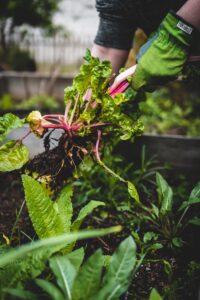Growing your vegetables can be a rewarding and cost-effective way to ensure a steady supply of fresh, organic produce in your backyard. However, the success of your vegetable garden heavily relies on the quality of your soil. This article will explore some practical tips and techniques to improve your vegetable garden soil, resulting in healthier plants and a bountiful harvest. From the importance of soil testing to the benefits of organic amendments, we will guide you through creating an ideal environment for your vegetables to thrive. Get ready to roll up your sleeves and give your garden soil the makeover it deserves!
Understanding the Importance of Soil Health
The role of soil in the success of your vegetable garden
When it comes to growing a thriving vegetable garden, one of the most important factors to consider is the health of your soil. Soil is the foundation for your plants, providing them with essential nutrients, water, and support. It serves as the medium for root growth and provides a habitat for beneficial organisms. Understanding soil’s role in your garden’s success is crucial for achieving bountiful harvests.
The impact of soil health on plant growth and productivity
Soil health has a significant impact on plant growth and productivity. Healthy soil provides the necessary nutrients, such as nitrogen, phosphorus, and potassium, for optimal growth. It also retains moisture, ensuring that plants have access to an adequate water supply. In addition, healthy soil promotes root development, which enhances the plant’s ability to take up nutrients and water.
Furthermore, soil health influences the microbial activity within the soil. Beneficial microorganisms such as bacteria, fungi, and earthworms help break down organic matter, releasing nutrients for plants to absorb. They also aid in controlling pests and diseases, creating a balanced and thriving ecosystem underground. By focusing on improving soil health, you can create an environment that supports the growth and productivity of your vegetable garden.
Testing Your Soil
The importance of soil testing
Before amending your soil, it is crucial to test its composition and nutrient levels. Soil testing helps you understand its current state, allowing you to make informed decisions about improving it. You can tailor your approach to address specific deficiencies and maximize plant growth by analyzing the pH level, nutrient content, and soil composition.
How to collect soil samples
Collecting soil samples for testing is a simple and essential step in assessing your soil’s health. Begin by dividing your garden into sections based on soil type or plant growth similarities. A trowel or soil probe should collect samples 6 inches deep from various areas within each section. Combine the samples in a clean container, ensuring there is no contamination. Repeat this process for each section and label the containers accordingly. Finally, the samples will be analyzed in a soil testing laboratory.
Interpreting the results of a soil test
Upon receiving your soil test results, it is essential to understand how to interpret them. The soil test report will provide information on the pH level, nutrient composition, and necessary amendments for your specific soil type. Understanding these findings will help you determine what adjustments need to be made. You can then choose the appropriate amendments and implement a plan to improve your soil’s health based on the recommendations provided.
Amending Your Soil
Identifying soil deficiencies
Once you have the results of your soil test, you can identify any deficiencies that may be present. Common deficiencies include nitrogen, phosphorus, potassium, and micronutrients. Nitrogen deficiency, for example, is often indicated by pale or yellowing leaves, stunted growth, and poor fruit development. By identifying these deficiencies, you can take steps to amend your soil and provide the necessary nutrients for healthy plant growth.
Choosing the proper amendments for your soil type
Choosing the proper amendments for your soil type is crucial for improving its health. Organic matter, such as compost or well-rotted manure, can be added to improve soil structure and fertility. This helps increase water retention and nutrient availability. Additionally, incorporating a balanced organic fertilizer can provide the necessary nutrients. Understanding the specific needs of your plants and soil type will help you choose the proper amendments for optimal results.
Adding organic matter to improve soil structure
Adding organic matter is one of the most effective ways to improve your soil’s health. Organic matter, such as compost or well-decomposed manure, helps improve soil structure, drainage, and nutrient-holding capacity. It also encourages the growth of beneficial microorganisms, which further enhances soil fertility. Add a generous layer of compost or organic matter to the surface of your soil and incorporate it using a garden fork or tiller. Repeat this process annually to improve the soil structure continually.
Using fertilizers and compost
Fertilizers, in addition to organic matter, can supplement your plants’ nutrient needs. Look for a balanced organic fertilizer that contains a mix of nitrogen, phosphorus, and potassium. This will help ensure your plants receive the nutrients for optimal growth. Following the recommended application rates and timing is essential to avoid overfertilization, which can lead to nutrient imbalances or environmental pollution. Regularly incorporating compost into your garden beds helps replenish nutrients and promote soil health.
Maintaining Proper Drainage
The impact of poor drainage on plant health
Proper drainage is essential for the health and vitality of your plants. When soil becomes overly saturated or soggy, it deprives the plant roots of much-needed oxygen. This can lead to root rot, stunted growth, and even plant death. Poor drainage also increases the risk of soil erosion and nutrient leaching. Ensuring your soil has adequate drainage is critical for maintaining the overall health of your vegetable garden.
Improving drainage through raised beds or mounds
If your soil has poor drainage, there are several techniques you can use to improve it. Raised beds or mounds are an effective way to create optimal drainage conditions. They elevate the planting area and prevent waterlogging, allowing excess water to drain away more efficiently. Raised beds also warm up faster in the spring, providing an extended growing season. This method is particularly beneficial for heavy clay soils prone to compaction and poor drainage.
Adding drainage materials like gravel or sand
In some cases, adding materials like gravel or sand can help improve soil drainage. Adding coarse sand can help break up the dense structure and increase permeability for soils with a high clay content. Similarly, incorporating gravel into the soil can create channels for water to flow through, reducing the risk of water saturation. It is important to note that these materials should be used sparingly and in the appropriate proportions to avoid creating an unstable or imbalanced soil structure.
Managing Soil pH Levels
The importance of pH for nutrient availability
Soil pH plays a crucial role in providing essential nutrients to your plants. pH measures the soil’s acidic or alkaline on a scale of 0 to 14. Most vegetable plants prefer a slightly acidic to neutral pH range between 6.0 and 7.0. When the soil pH is outside of this optimal range, certain nutrients may become unavailable to the plants, even if they are in the soil. Therefore, it is essential to manage and adjust your soil pH accordingly.
Testing and adjusting soil pH
To determine the pH level of your soil, you can purchase a soil pH test kit or have a soil test conducted by a lab. Follow the instructions provided with the test kit, or submit your soil sample to the lab for analysis. The test results will indicate the current pH level of your soil. If the pH is too acidic, you can raise it by adding lime. You can lower it by adding elemental sulfur if it is too alkaline. Monitoring and adjusting your soil pH regularly is essential to ensure optimal plant nutrient availability.
Choosing plants that thrive in your soil pH
Different plants have varying pH preferences, and choosing varieties well-suited to your soil pH can significantly improve their growth and productivity. Some plants, like blueberries, prefer acidic soil, while others, like asparagus, thrive in slightly alkaline conditions. By selecting plants adapted to your soil pH, you can optimize their ability to absorb nutrients and reduce the likelihood of nutrient deficiencies or toxicities.
Controlling Soil Erosion
Understanding the causes and consequences of soil erosion
Soil erosion refers to losing topsoil due to wind or water movement. This process can occur naturally but is often accelerated by improper land management, intense rainfall, or excessive tillage. Soil erosion can have severe consequences for your vegetable garden, including nutrient depletion, reduced water-holding capacity, and decreased soil fertility. Understanding the causes and consequences of soil erosion is crucial to implementing effective erosion control measures.
Implementing erosion control measures like mulching and cover cropping
You can employ various erosion control measures to protect your soil from erosion. Mulching is a popular method that covers the soil surface with a layer of organic material, such as straw, wood chips, or leaves. This helps reduce water runoff, minimizes soil compaction, and preserves moisture. Cover cropping is another effective technique where you sow a specific mix of plants, called cover crops, to cover and protect bare soil. These cover crops help stabilize the soil, reduce erosion, and improve soil health by incorporating organic matter.
Managing Soil Compaction
Identifying the signs of soil compaction
Soil compaction occurs when the soil particles are tightly packed together, reducing pore space and limiting the movement of air, water, and nutrients. Compacted soil can impact plant growth by hindering root development, nutrient absorption, and water infiltration. Signs of soil compaction include poor water drainage, stunted growth, and increased runoff during rainfall. Recognizing these signs is crucial in implementing measures to alleviate soil compaction.
Preventing soil compaction through proper garden practices
Preventing soil compaction starts with implementing proper garden practices. Avoid working on wet soil, as it is more prone to compaction. Instead, wait until the soil has dried out sufficiently. Additionally, minimize foot traffic in the garden and use designated paths or stepping stones to avoid compacting the soil. Adding organic matter, as mentioned earlier, can help improve soil structure and reduce the likelihood of compaction.
Using methods like aeration or tilling to alleviate compaction
In cases where soil compaction has already occurred, there are methods you can use to alleviate it. Aeration involves creating small holes in the soil to increase air and water penetration. This can be done using a manual or mechanical aerator. Tilling is another method that involves breaking up compacted soil by turning it over. However, excessive tilling should be avoided as it can disrupt soil structure and lead to erosion. These techniques should be used judiciously and only when necessary to ensure the overall health and integrity of the soil.
Beneficial Soil Organisms
The role of beneficial microorganisms in soil health
Beneficial microorganisms, such as bacteria, fungi, and earthworms, promote soil health. They help break down organic matter, releasing essential nutrients for plant uptake. These microorganisms also aid in suppressing disease-causing organisms and pests, contributing to a healthy and balanced soil ecosystem. By fostering the growth of beneficial soil organisms, you can enhance your soil’s overall health and fertility.
Encouraging soil biodiversity through organic gardening practices
Organic gardening promotes soil biodiversity, which is critical to maintaining a healthy ecosystem. Avoiding synthetic pesticides and chemical fertilizers helps preserve the diversity of microorganisms in the soil. Instead, use natural crop rotation, composting, and companion planting to foster soil biodiversity. These practices create an environment that supports beneficial microorganisms, promoting plant growth and reducing the risk of pests and diseases.
Using compost tea or microbial inoculants
Compost tea and microbial inoculants can boost the population of beneficial microorganisms in the soil. Compost tea is created by steeping compost in water, allowing the beneficial organisms to multiply. This nutrient-rich liquid can be applied to the soil or used as a foliar spray. Microbial inoculants, on the other hand, are commercially available products that contain specific strains of beneficial bacteria or fungi. These inoculants can be applied to the soil to introduce or enhance the population of beneficial microorganisms.
Crop Rotation
The benefits of crop rotation for soil health
Crop rotation is a technique that involves systematically changing the types of crops grown in specific areas of your garden over time. This practice provides numerous benefits for soil health. First, it helps reduce the buildup of pests and diseases, as different crops attract different pests and diseases. Second, crop rotation improves soil fertility by alternating the nutrient requirements of other crops. Finally, it enhances soil structure by varying the root systems of crops, which can help break up compacted soil and improve water and nutrient uptake.
Planning a crop rotation schedule
When planning a crop rotation schedule, consider the specific needs and characteristics of each crop you intend to grow. Group crops that have similar nutrient requirements and growth habits together. Rotate families of crops, such as nightshades, brassicas, and legumes, to help break pest and disease cycles. Consider the space and crop rotation requirements of each plant. By carefully planning your crop rotation, you can maximize your soil health and overall garden productivity benefits.
Choosing complementary plants for crop rotation
To optimize the benefits of crop rotation, choose complementary plants that work well together. For example, legumes, such as peas or beans, can fix nitrogen in the soil, making them ideal for follow-up crops that require higher nitrogen levels. Brassicas, such as cabbage or broccoli, are typically followed by crops that benefit from their ability to break up compacted soil. Selecting complementary plants based on nutrient requirements, growth habits, and soil improvement characteristics will help maintain the health and fertility of your soil.
Cover Cropping
The advantages of cover cropping
Cover cropping is a practice that involves planting a specific type of crop to cover the soil surface during periods when the main vegetable crops are not being grown. There are numerous advantages to cover cropping. First, covering crops helps prevent soil erosion by protecting the soil against wind and water. They also improve soil fertility by adding organic matter when incorporated into the soil. Additionally, covering crops suppresses weeds, enhances nutrient cycling, and provides a habitat for beneficial insects.
Selecting cover crop species for different purposes
Different cover crop species serve other purposes, and choosing the right ones for your garden is crucial. Legumes, such as clover or vetch, are nitrogen-fixing cover crops that can enrich the soil with nitrogen. Grasses, like rye or oats, help build soil structure and control weeds. Brassicas, such as mustard or radishes, act as biofumigants, releasing compounds that suppress pests and diseases. When selecting cover crops, consider their specific benefits and choose species that align with your soil improvement goals.
The process of planting and managing cover crops
Planting and managing cover crops require careful consideration to ensure their success. First, prepare the soil by removing existing vegetation and breaking up compacted areas. Broadcast the cover crop seeds evenly across the soil surface and lightly rake them in. Depending on the cover crop species, they may need to be sown at specific times of the year. After planting, monitor the growth and development of the cover crops and incorporate them into the soil before they set seed. This will maximize their benefits to the soil and ensure the next crop can be planted successfully.
By understanding the importance of soil health and implementing strategies to improve it, you can create an environment that fosters the growth and productivity of your vegetable garden. Testing and amending your soil, managing drainage and pH levels, controlling erosion and compaction, nurturing beneficial soil organisms, and implementing crop rotation and cover cropping practices create healthy and fertile soil. With careful attention to your soil’s needs, you can cultivate a thriving vegetable garden and enjoy abundant harvests season after season.



